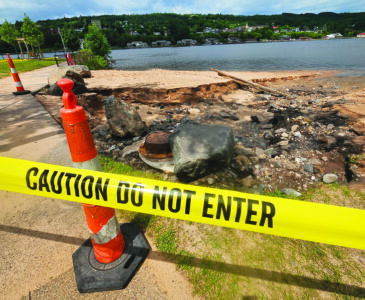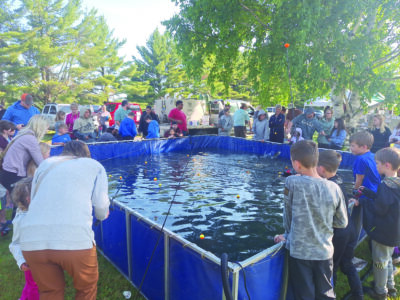Enbridge Line 5 pipeline: What you should know
LANSING — Since she took office in 2019, Gretchen Whitmer has made it among her priorities to stop the use of Line 5 for the transportation of petroleum-based products through the Straits of Mackinac.
Enbridge Energy’s Line 5 pipeline was built in 1953, and extends for 645 miles across the state of Michigan. Line 5, which is part of Enbridge’s Lakehead System, begins in Superior, Wisconsin, and ends in Sarnia, Canada.
The state of Michigan granted the request of Enbridge, a $125-billion Alberta, Canada-based oil transport company, for a right-of-way to build, lay and secure two pipes along the lake bottom in the Straits. The pipelines became operational in 1953. Today, they carry up to 23 million gallons daily of light crude oil and liquid natural gas (for propane). The pipeline has been a source of controversy since it was constructed.
The Bechtel Corporation, the University of Michigan’s Department of Naval Architecture and Marine Studies, and Columbia University’s Civil Engineering Department were involved in the engineering, design, and construction process, states Enbridge. To promote the safety and integrity of the crossing, support anchors have been constructed and placed along the section of Line 5 that runs beneath the Straits of Mackinac. While federal regulations allow for a span of up to 140 feet between underwater support anchors, Enbridge committed to further enhancing the safety of the crossing by placing additional anchors beneath the Straits crossing. Today, the Line 5 Straits crossing has 128 support anchors, none of which are more than 75 feet apart.
Enbridge states, on its website, that Line 5 was built for the underwater environment, with nearly one-inch-thick steel walls and fiber-reinforced enamel coating. It was built by Merritt-Chapman & Scott, the same company that built the Mackinac Bridge, using the same kind of steel. Like the bridge, the intention has always been to operate and maintain it carefully to maximize its lifespan. Recent inspection reports show that Line 5, from an engineering and integrity perspective, is like new and in excellent condition.
Enbridge operates the world’s longest crude oil and liquids transportation system across the U.S. and Canada, and has a significant and growing involvement in natural gas gathering, transmission and, midstream business, as well as an increasing involvement in power transmission. Enbridge delivers about 2.5 million barrels of oil and an average of almost 7 billion cubic feet of natural gas each day.
In total, Enbridge has four wholly-owned pipelines in Michigan, totaling about 930 miles of pipe: Line 5 traverses through Northern (Upper) Michigan, Line 6B traverses across Southern Michigan, and Line 17 and Line 79 feed markets in Detroit and Toledo.
In addition, Vector Pipeline is a joint venture between Enbridge and DTE Energy. Vector Pipeline is a 348-mile, 42-inch pipeline that transports approximately 1.3 billion cubic feet per day (Bcf/d) of natural gas from Joliet, Illinois in the Chicago area to parts of Indiana and Michigan and into Ontario, Canada.
According to Enbridge, about 30% of the volume carried by Line 5 (35,000 barrels per day) is delivered to Marathon’s Detroit refinery as well as refineries in Ohio. In addition, Enbridge claims Line 5 delivers 65% of the propane that heats Upper Peninsula homes, and 55% of Michigan’s propane needs. Much of the focus for Line 5 has revolved around the dual pipelines located on the bottom of the Straits of Mackinac. However, this represents just a small portion of Line 5, just over 4 miles out of a total 645 miles. Those figures are disputed by the Mackinac Center.
Opponents claim that the onshore portions of Line 5 pose just as much, if not a greater, risk to Michigan’s waters, even though it has not suffered a failure in 68 years.
In the Upper Peninsula, according to the Tip of the Mitt Watershed Council, Line 5 crosses 16 tributaries within nine miles of Lake Michigan, 11 of those are less than four miles from the lake. That means an oil spill in this area would have a high likelihood of reaching Lake Michigan. In the Northern Lower Peninsula, Line 5 crosses the Indian River, Little Sturgeon River, Pigeon River, and Upper Black River and traverses within a few miles or less from many sparkling inland lakes, including Paradise, Burt, Mullet, and Douglas.
The Line 5 Straits of Mackinac crossing remains in excellent condition, and has never experienced a leak in more than 65 years of operation. The Line 5 crossing features an exceptional and incredibly durable enamel coating, and pipe walls that are three times as thick–a minimum of 0.812 inches–as those of a typical pipeline.
What’s more, the Bechtel Corporation — renowned for the Hoover Dam — designed and built Line 5 in an area of the Straits that would minimize potential corrosion due to lack of oxygen and the cold water temperature. This setting contributes to preserving the integrity of Line 5, which has enabled it to serve the region safely and reliably for more than six decades.
The movement through Line 5 consists of natural gas liquids, such as butane, ethane, and propane, batched with various light products including crude oil and condensates. These light crudes and natural gas liquids are transported to multiple Great Lakes refineries.
Synthetic crude from oil sand deposits in the Western Canada Sedimentary Basin are transported through Line 5. However, this synthetic crude is different from the diluted bitumen (dilbit) or heavy oil sands crude that spilled into the Kalamazoo River near Marshall, Michigan, in 2010.
The Watershed Council also reported that the portion of pipelines in the Straits have automatic shutoff valves where the valves will shut automatically in the event that pressure drops, starting a shutdown of Line 5. The pipelines are generally operated around 200 pounds per square inch (psi), with a daily range of 0-300 psi. The valve on the west line automatically closes if pressure levels fall below 65 psi and the valve on the east line automatically closes if pressure drops below 45 psi. These automatic shut-off valves take approximately three minutes to close. There is also electric backup generation at the Straits to make sure valves can operate in the event of a power outage. Based on the automatic shut-off valves closing correctly, the approximate volume of oil released from a single pipeline between the valves would be 4,950 barrels or 207,900 gallons.
The estimate for the worst-case discharge at the Straits of Mackinac is 8,583 barrels or 360,486 gallons. According to Enbridge, this estimate reflects a worst-case discharge that could occur at the Straits in a real world scenario and takes into account pipe elevation as opposed to flat ground elevation.
According to Enbridge, approximately 15 billion barrels of crude oil and liquids were transported in their pipeline system over the last 10 years and 99.9994 percent of that volume was delivered safely. However, there is an inherent risk associated with pipelines and accidents happen.
Across the entire Enbridge liquids pipeline system, the total number of reportable spills between 2005-14 was 763 with a total volume of almost 4 million gallons of product spilled. The majority of these spills are relatively small and occur on Enbridge property, such as pump stations.





